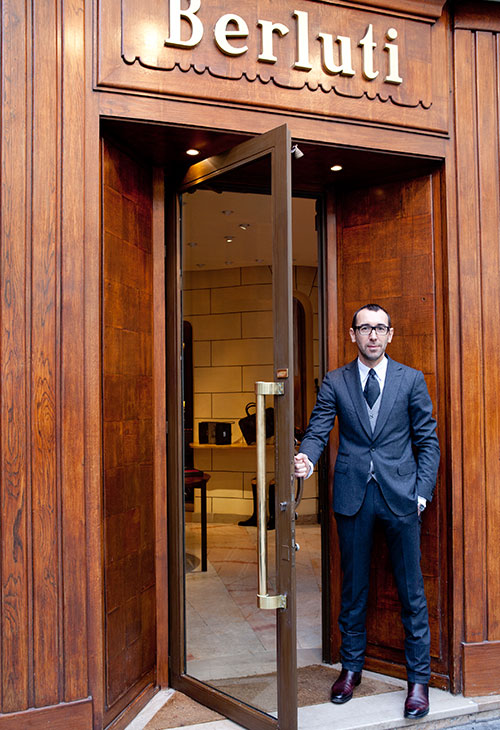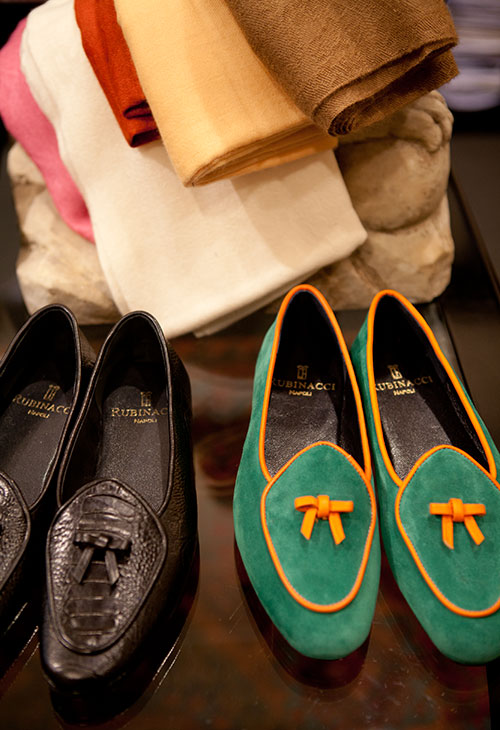Previous Article
Next Article
- AM WORLD
- 100 YEARS OF ASTON MARTIN
THE DRIVE
A CUT ABOVE THE REST
In search of the perfect gentleman’s suit, Josh Sims takes the V12 Zagato on a sartorial odyssey through Paris to the car’s spiritual home in Milan
Photographs by Beatriz da Costa
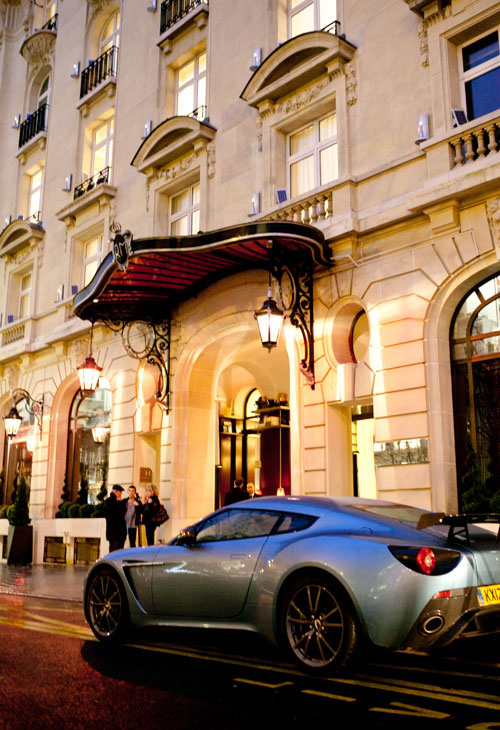
Right: the Zagato looks at home parked for the night outside the Le Royal Monceau, Raffles in Paris
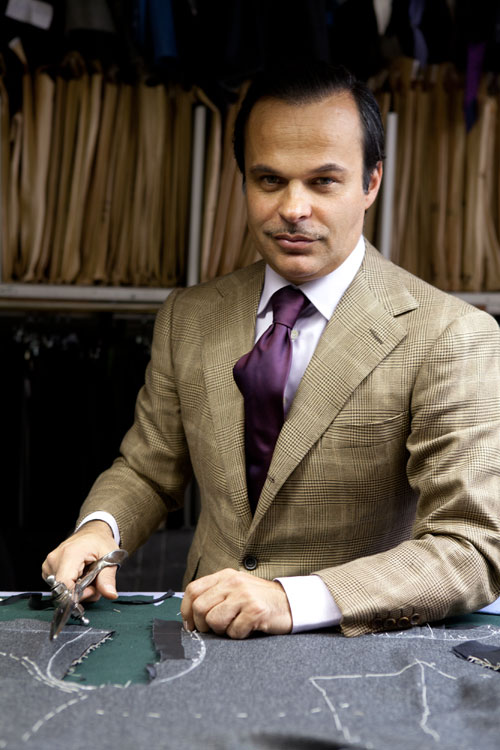
Lorenzo Cifonelli, a fourth-generation Parisian tailor, blends Italian and English styles
You could tell from his moustache that he knew how to cut cloth. Lorenzo Cifonelli, fourth generation of a Parisian family tailoring business—back in the 1920s his grandfather dressed Josephine Baker among others—has facial hair as precise as his outsized scissors. And with his deep tan, slicked-back hair and soft tailoring, he’s every inch the golden age, matinee idol. He would look as out of place on grey, serious Savile Row as a denim tutu. But then, Savile Row, I had decided, was far too close to home to begin my search for a new tailor. I needed to be an English gentleman capable of, just for a while, embracing the Euro and setting off for those other fashion capitals, Paris and Milan.
The idea occurred after a burst of aggressive acceleration encouraged closer attention to the double-bubble roof lining of the Aston Martin Zagato—itself a product of Italian styling by the famed coach-builder who, 50 years ago this year, had lent its first touch to an Aston Martin. It’s a relationship that has continued with Vantages and Volantes, and now 101 new spoiler-crested racers. The Zagato’s leather is decorated with waves of intricate stitching, as though Cifonelli himself had worked his needle. And there’s the sudden, sad realisation that a roof can be better turned out than myself.
Something must be done. Something that would also provide an excuse to rocket down the nearly empty motorways from Calais to Paris, following a very smooth crossing under the Channel with Eurotunnel, to the rumbling gurgle of the V12 engine. It’s a sound rather more tuneful that the French pop offered by the radio, or the grumblings of French customs officers and, sizing up the Zagato, their repeated question about whether I was carrying more than 10,000 Euros in cash. Encore et encore, non!
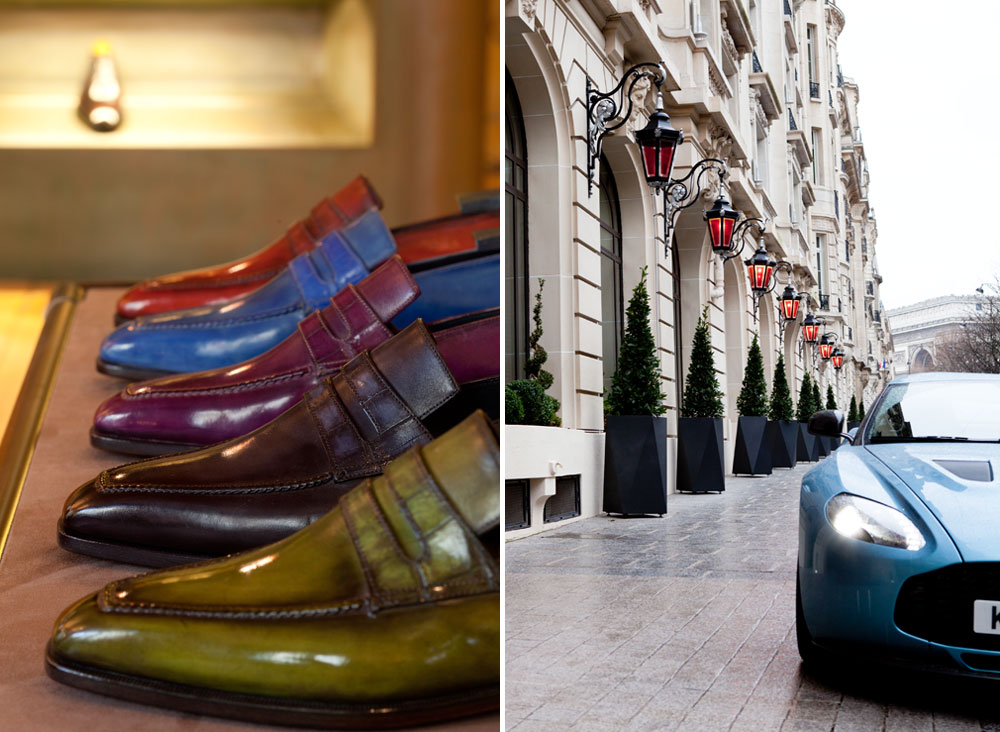
Left: fine footwear at Berluti; Right: the Zagato pauses for breath outside the hotel in Paris
Cifonelli’s would be a natural first port of call, not least because its blend of soft Italian and stiff English tailoring styles; great granddaddy Massimo Cifonelli trained in London before founding the company in Rome, soon moving to Paris to build what is now the capital’s biggest tailoring workshop. It just so happens that Cifonelli’s summer 2013 promo material features a client’s Aston Martin One-77. “In fact,” says Lorenzo Cifonelli, “we seem to have a lot of clients who love Aston Martin. And, as a tailor, we are more Aston Martin than Ferrari—and I speak as an Italian. It’s about elegance, and the importance of all the work inside that you don’t see. Similarly, while heritage is important, I don’t want to make suits like those of my grandfather, or even father. Tailors can often be very rigid in their ideas, but you have to understand how people live today and keep moving forward.”
That’s achieved by tailoring, for example, a knitted jacket, double-breasted with single-breasted lapels and inspired by Roger Moore in The Persuaders, or making another jacket out of yak wool, a kind of tweed with a Tibetan twist. “Paris may be less well-known than London for bespoke tailoring for men,” Cifonelli concedes, teasingly flashing the name of a famous American designer who was having his own suits made by them, “but those that are here are very strong on the details, in that couture way.”
The aptly named Alessandro Sartori, the one-time designer for Zegna, and now creative director of the new tailoring-based menswear line from French shoemaker Berluti, sips his thick espresso. “Does the Frenchness of clothing appeal?” asks the Italian. “Certainly, there is to Frenchness a certain impertinence, if I can call it that. There is a difference to French tailoring that is quite specific.”
He draws my attention to the time-worn nubbly pilling of his overcoat, as if to suggest that he isn’t being paid enough. But it turns out it is made from cashmere that has been hand-abraded precisely to give it that cosy, comforting old-coat feel. “That is not something an Italian company would normally do,” Sartori says. “They tend to like everything to look brand new. It was a surprise to me to find as many bespoke tailors in Paris as I did—they’re enjoying a second spring.” Then he shows a one-button alpaca jacket with rolling lapels, narrow sleeves and subtle chalk stripe made by the Berluti-owned, Parisian Alys Atelier; it could have been passed down from his own grandfather. Sartori is certainly big on the idea of returning to a pre-war era when men were more inclined to buy less but much better, such that their clothes would inevitably be handed down.
“The recession has been one incentive towards that. There is less money, so people are more careful about what they buy, but then they are also more inclined towards the hand-made, which at the top may mean paying a little extra. We’re happy to do so because it gives real quality and real value,” Sartori explains. “There is a new demand for calm, for the beautiful, in clothes as in cars, which need to be cool, sexy, modern. I have a vintage BMW that I love. But Aston Martin—ooph!”
Indeed, there is much to ponder about my tailoring choices, so it is time to climb back into the Zagato and jiggle its racing suspension and seating over the cobbles of Parisian backstreets to my abode for the night, Le Royal Monceau, Raffles Paris. Now 85 years old, having courted the likes of Ernest Hemingway, Maurice Chevalier, Ray Charles and (she gets everywhere) Josephine Baker, it was remodelled two years ago by designer Philippe Starck into, as Sartori might have it, something cool, sexy and modern.
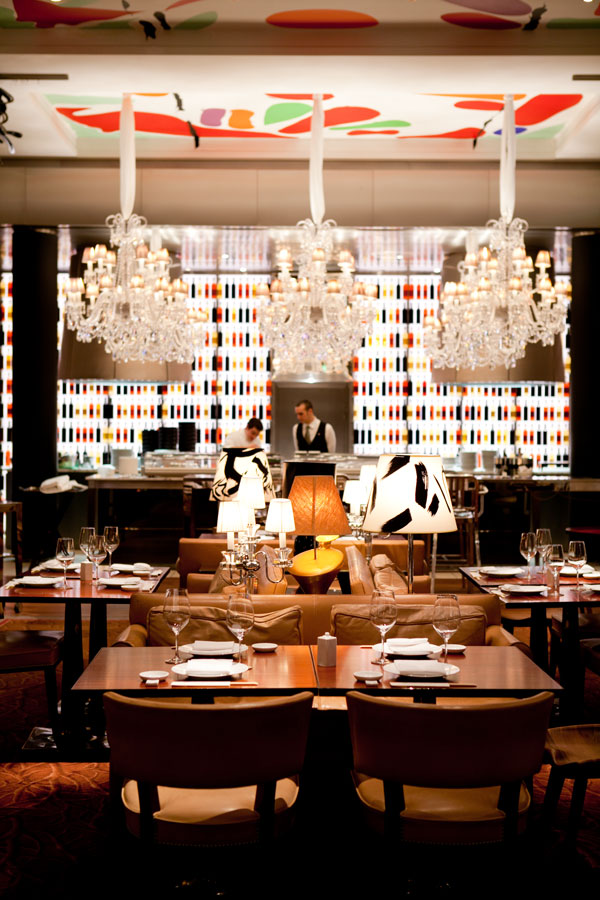
La Cuisine restaurant at Le Royal Monceau, Raffles Paris, was remodelled two years ago as part of a makeover by celebrated French designer Philippe Starck
Having found my way out of the mirror-tiled bathroom, tumbled on to the bed, switched on the giant TV and avoided the call to perform my best Bob Dylan impression being made by the guitar standing butler-like in a corner of the suite, it was time to consider the big question: how many roads must a man drive down, before they deliver the perfect suit?
Next morning’s blow-out of various Pierre Hermé buns at breakfast offered no answer, other than prefigure the need for my prospective tailor to have a longer tape measure. More thinking time would be required, away from the hotel’s alarmingly edgy crowd and the city’s painfully chic populace, away from the paparazzi-persistent car-spotters who gathered around what I’m sure the bell hops referred to as “Ze Za-gateau”. And where does a gentleman go to think, aside from his club? His car. More precisely, he goes to his car and then goes to the Côte d’Azur, the land of curving seaside roads, of cinematic car commercials... and Lycra-clad septuagenarian cyclists hogging the middle of the road.
Ah, well. I conclude it is as easy to be impressed by rapid braking as by acceleration and to enjoy the view of the Bay of Angels, seemingly ending somewhere in 1780, if the staff uniforms at Le Negresco hotel in Nice are anything to go by. Frock coats, pantaloons and stockings may all add to the gently faded old world glamour of the place—this, after all, was the post-playground recovery spot for Marlene Dietrich and Salvador Dalí in the 1950s, as well as that of Bardot, Burton and The Beatles the decade after—but it only provides inspiration as to what I wouldn’t request of my new tailor.
Le Negresco’s contrast with Le Royal Monceau could not be more stark, or less Starck. Celebrating its century this year—like Aston Martin—Le Negresco’s dark wood-panelled bar, plush, red velvet-lined lift, eclectic art-lined corridors, hanger-sized ballroom, listed frontage and the occasional imperial ‘N’ motif all add up to a quirky home-from-home that is Napoleonic meets Swinging Sixties. Picture the Emperor flouncing from a Riva speedboat, bicorn hat in one hand, a champagne bottle in the other, and one has an idea of how the hotel has maintained a potential for decadence on which the coast’s reputation has been built.

Left: traditional splendour at Le Negresco in Nice, which, like Aston Martin, is celebrating its centenary this year. Right: the Riviera’s coastline is almost as eye-catching as the Zagato itself
Perfectly crumpled linen might be more the style here—but that would not cut la moutarde back under grey British skies. So it’s onwards past peak-perched Bond villain lairs, through mountain tunnels—enjoying the Zagato’s characterful engine note echoing off the walls—and onwards towards the fashion quarter of Milan, with its famed Via Montenapoleone, lined with one Italian global brand-name after another. Conveniently located among them was the Four Seasons where, ostentatiously parked in the hotel driveway, the Zagato made a suitable snub to passing prancing horses.
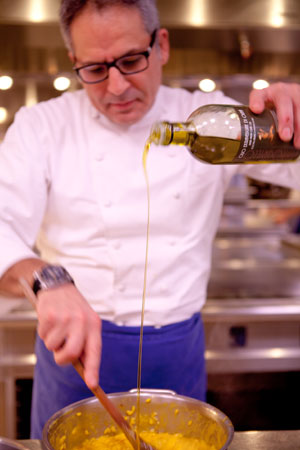
Preparing dinner in the kitchens of the Four Seasons in Milan
Yet this will not do at all for my quest. It is one thing to be encouraged towards sobriety in the bar by its grand, worn stone pillars—an ironic reminder that it stood on the 15th-century church grounds of a former convent—yet for the hotel to offer at lunchtime a whole room devoted to innumerable chocolate treats is taking the biscuit. What use is it to turn up for my first bespoke-suit fitting several pounds heavier than normal?
There is only one solution: burn it off by running to the next tailor’s appointment. And that might have worked, had Rubinacci’s premises not been situated just a few seconds’ walk away; the Zagato might do 0 to 100kph in 4.2 seconds, but this pale and puffy Englishman is considerably slower. Luckily, the world of Rubinacci provides a soft landing: cashmere cardigans, cashmere sweaters, even cashmere shirts and cashmere socks.
“Everyone in fashion now is trying to push design so attention is drawn to the wearer as much as possible. But gentlemanly dressing is not about being seen. It is about discretion, about the details,” says Luca Rubinacci, the third generation of a family business originally founded in 1932 as London House, an Anglophile nod that belied its emphasis on the Neapolitan cut: minimal padding, a natural shoulder, perhaps half-lined, more fitted, subtle.
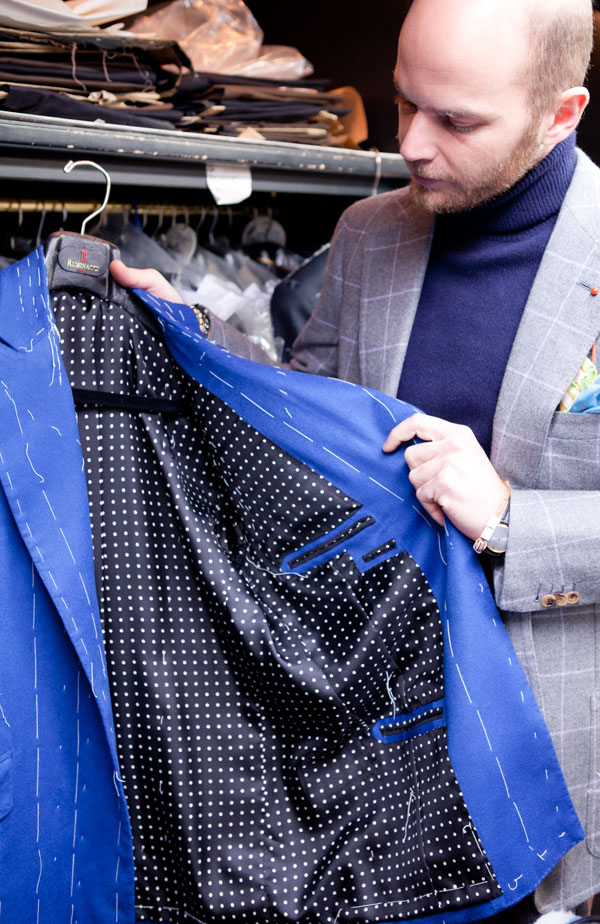
Luca Rubinacci and an example of his exquisite Milanese tailoring.
“As Oscar Wilde said, fashion is so bad they have to change it every six months. Tailoring is not about fashion, or what’s cool. It’s not about changing your wardrobe, but building on it,” says Rubinacci. “Modern tailors are as much stylists as makers of suits. And, frankly, fashion labels are not only getting too ubiquitous, they’re too expensive. You may as well go bespoke.” I’m trying, Luca, I’m trying. He shows me a few examples: a dinner-suit jacket that looks officiously correct, but with an outlandishly baroque silk lining; or another client’s plain navy suit, with a lining featuring an image of Admiral Nelson’s flagship, Victory, “because Nelson liked to visit Naples,” adds Rubinacci, “for the lovers.” He quickly marries it with a tie—unlined, as they were originally made, so requiring more fabric and more craft—and, boom, pure style. “Bespoke tailoring is about finding a sensibility for beauty, as with a passion some men have for watches or cars. When you go to Aston Martin, you’re buying less a car and more an idea. It’s the same here,” he says.
“I would love to have an Aston Martin,” he adds. “But it will be a long time before I can afford one. I will have to make many more suits.”
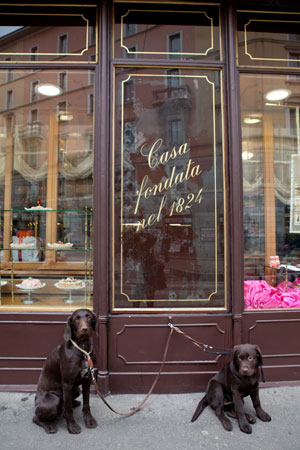
Zagato feels very much at home in Milan, known for its chic boutiques.
I feel I’m getting closer to wearing one of them when I’m reminded that the Zagato has an appointment with, if you like, its own master cutter. The House of Zagato, as Italy’s last independent car design company might be called were it a fashion company, is responsible for this very special car’s own distinctive silhouette. And it is time for my Zagato to pay a visit for a final fitting.
It is not alone: like the best tailors, Zagato, founded in 1919, has many esteemed clients—the likes of Diatto, Alfa Romeo, Maserati, Lamborghini, Bentley and Lancia—about which it is as discreet as any tailor would be. But Alvise-Marco Seno, Zagato’s spokesman, looking admiringly at the latest Aston Martin, recalls a special relationship: how the company was asked by David Brown to give the DB4 GT a lighter touch and created, as Seno modestly puts it, “a masterpiece in the world of car collecting”.
Zagato, he explains, comes out of a history in aerodynamics rather than traditional horse-drawn coach-building, which quickly gave the company a signature look—a functional, minimalistic shape, best to cut through the air—and a reputation for specialising in coupés. “A Zagato is not a car for football players,” says Seno. “It’s an atelier car, for someone who wants to be involved in his car. Yes, such a car comes with a high price, but customers might also find that their Zagato will be collectible.”
I may be no closer to being beautifully attired myself, but whenever that burst of speed prompts another glimpse at that intricately stitched roof lining, I can take comfort in my wheels being the best-dressed in town.
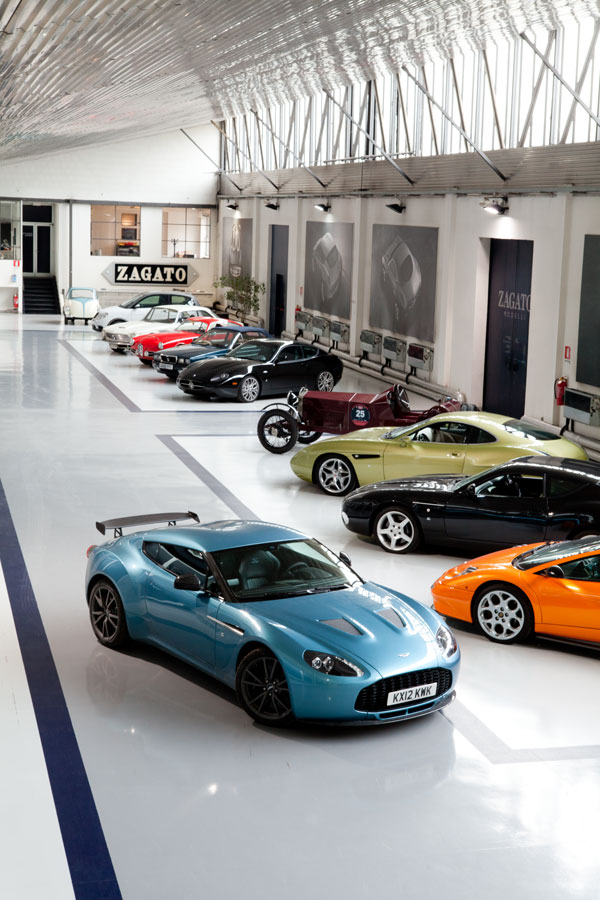
The V12 takes pride of place in Zagato’s showroom alongside other classic models that reflect the company’s fruitful collaboration with Aston Martin
Eurotunnel
Tel: +44 (0) 8443 35 35 35
www.eurotunnel.com
Le Royal Monceau, Raffles
37 Avenue Hoche 75008, Paris
Tel: +331 42 99 88 00
www.raffles.com/paris
Le Negresco
37 Promenade des Anglais
06000, Nice
Tel: +33 (0) 4 93 16 64 00
www.hotel-negresco-nice.com
Four Seasons, Milan
Via Gesù, 6-8, 20121 Milan
Tel: +39 02 77088
www.fourseasons.com/milan
Previous Article
Next Article
- AM WORLD
- 100 YEARS OF ASTON MARTIN


